Learn String-Bending King Jerry Donahue's Headturning “Harptone” Technique
The Hellecasters and Fairport Convention guitarist explains how he wrings maximum sustain from his guitar by mixing open strings with fretted notes
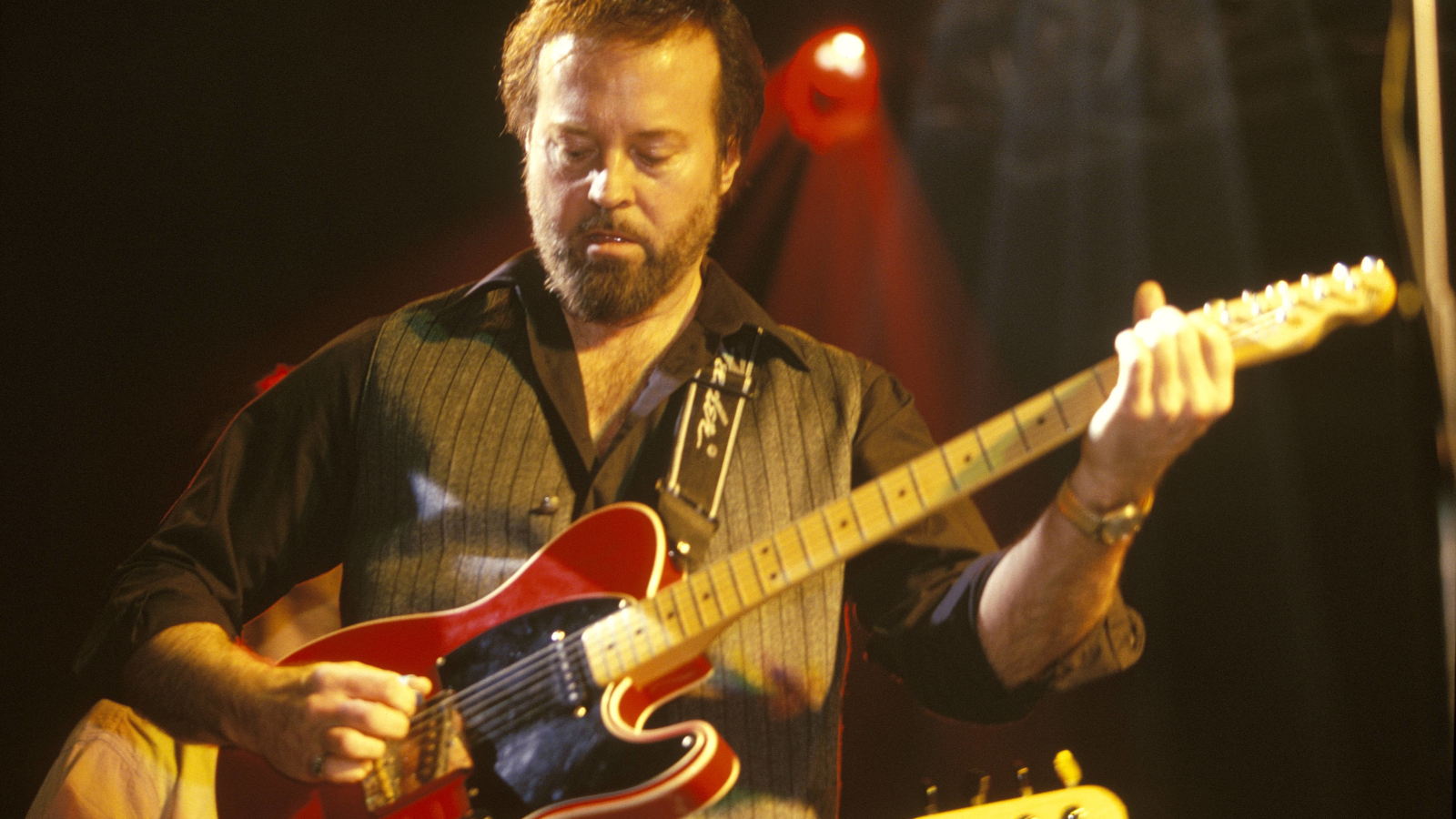
As one of the planet’s premier country pickers, Jerry Donahue keeps his trick bag well stocked with cool techniques. His behind-the-nut bending chops are second to none, and he’s adept at such contortions as releasing one bend while simultaneously raising another. Try it!
Donahue is also known for his ability to create chimey runs composed of alternating fretted notes and open strings. In this lesson, we’ll learn how Donahue wrings maximum sustain from his guitar using this “harptone” technique.
Though the following licks are delightfully twangy, you can adapt them to mellow jazz, chunky metal, and all points in between.
Hanging On
“In a harptone run, the idea is to allow all the strings to ring until the last possible moment,” Donahue explains. “Hang onto each fretted note until you have to let it go to finger another one, and be sure to let the open strings sustain against the fretted ones.”
To illustrate, Donahue picks Ex. 1.
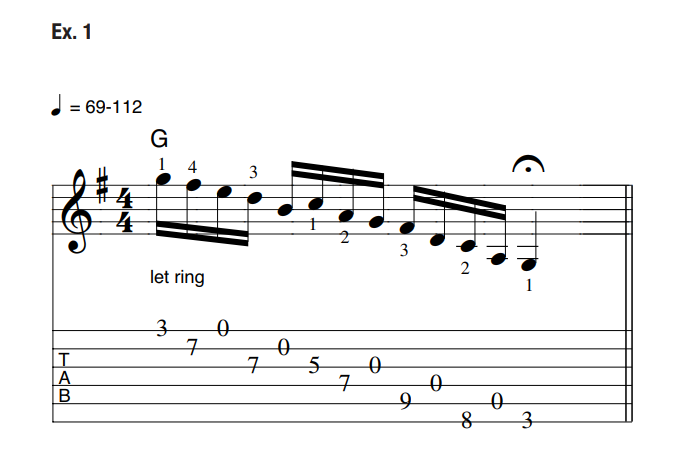
“This run makes a nice song ending against a G chord,” he continues. “If you were to play it using a normal scale fingering, you’d fret G and F# on the same string. This would force you to let go of G before playing F#. But in this case, you’re playing G and F# on adjacent strings, so you can let the notes rub against each other.
“The same thing happens when you play the third note – open E. It rings against the fretted F#. Then D rings against open E, and so on. The goal is to always have at least two notes ringing at the same time.”
All the latest guitar news, interviews, lessons, reviews, deals and more, direct to your inbox!
The phrase is derived from a descending G major scale. “If you fret all these notes,” says Donahue, “it’s just a scale run. But with the open strings, it’s magic.”
Musically, you’re creating a series of harmonic intervals within a melodic line. Most of these intervals are major or minor seconds – tangy sounds that beg for resolution and therefore keep your line surging forward.
“Sometimes you have three or even four notes ringing against each other,” Donahue reveals. In this lick, you can get F#, E, and D to sound together (beat one), and G, F#, D, and C to ring (beats two and three).
Even the most mundane melody – a major scale – comes alive when played using a combination of fretted notes and open strings.

Play Ex. 2, a straight G major scale, and prove this to yourself. Remember:
Arch your fretting fingers so the open strings can sustain freely.
Remove your finger from a fretted note only when that finger is needed to play another note.
Most notes in this example sustain two or three times longer than their written sixteenth-note value. Notating these durations would make the music virtually unreadable, but that’s okay – if you let your ears guide your fingers, you’ll be fine.
Chiming Through Changes
“Here’s a phrase in C,” says Donahue, playing Ex. 3.
In the space of one bar, this line carries you from the 13th fret to the 1st. It’s the open strings that keep the journey sounding smooth and unhurried.
Watch the pull-off in beat one, and let the paired open strings (beats two and three) cover your position shifts.
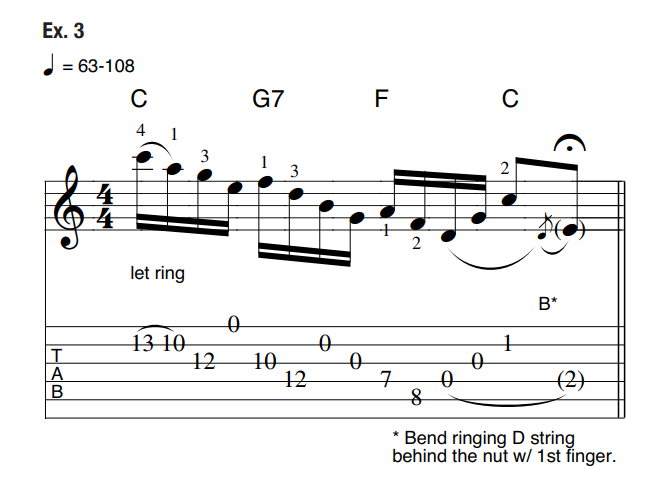
Donahue concludes this phrase with a behind-the-nut Telecaster bend, using his 1st finger to stretch the open D a whole-step up to E.
Warning: You can hurt yourself with this one! A safer alternative – one that won’t pull any muscles – is to hammer the already ringing open D to E. If you choose this option (either because your strings are too heavy to bend behind the nut, or because you’re not playing a guitar that permits this kind of bending), change the fingering: Play C with your 1st and hammer E with your 2nd. Easy.
“Again, look for ways to keep strings ringing,” reminds Donahue. “In beat one, keep A, G, and E sustaining.”
Likewise let D, B, and G (beat two), and F, D, and G (beat three) shimmer and clang.
Snappy Seconds
“This lick sounds really nice played using a Stratocaster’s middle and bridge pickups,” says Donahue, picking Ex. 4.
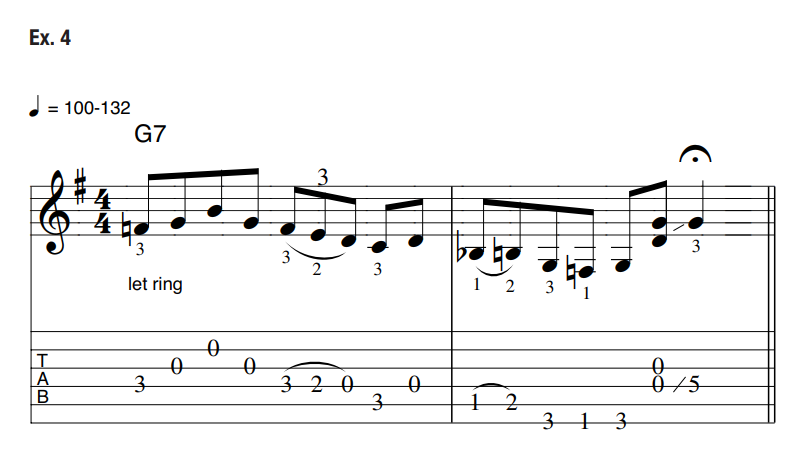
Emphasize the chiming major seconds (F-G and C-D) by vigorously plucking them. “You get a special, poppy sound if you do this with your fingers,” details Donahue. “Either use a flatpick in combination with your middle and ring fingers, or play with a thumb pick, index, and middle fingers.”
The lick concludes with a neat bluegrass slide that sets up unison G notes.
Ex. 5 shows how Donahue works a harptone line into a bluesy run. “I like this double bend,” he says, referring to bar 1’s callus burner, “for its pedalsteel sound.”

This challenging move involves holding a bent D and pre-bent F – just hitting these tones accurately is tricky enough – and smoothly releasing them in beat three.
“In one motion, you’re bending two frets on the third string and one fret on the second string,” says Donahue. “Just push both strings toward you. Somehow it works out.”
The chimey open strings kick in at bar 2. Notice beat three’s quarter-bend on Bb. “That’s the bluesy part,” Donahue declares. There’s more than one way to create ringing harmonies within a melodic line.
Ex. 6 contains no open strings, yet Donahue makes it chime and twang.

“The secret here is to keep the previous string sustaining when you move to a new one,” he explains. For example, look at the pickup notes going into bar 1: Once you play the Cn on the second string, hold it against the next three tones on the first string.
Apply this idea to the rest of the phrase, and be sure to let the final three notes (C, F#, and D) bleed together. They set up a swampy D7 with a major second as the lowest interval. Thelonious Monk meets Robert Johnson – excellent!
Electronic Sounds
Harptone runs make nifty loops.
Try Ex. 7 with some shimmering delay.
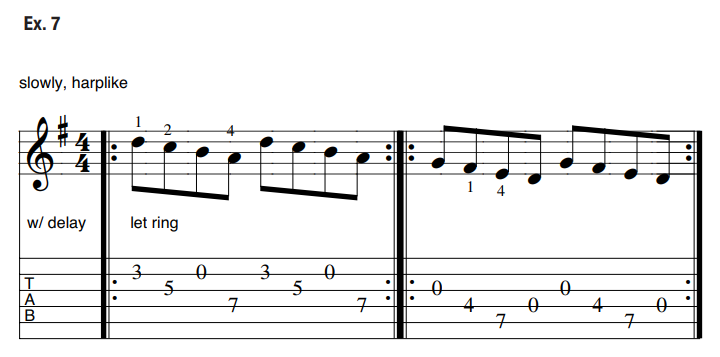
Another looping candidate, Ex. 8 sounds terrific with a slow, resonant flange.
Play bar 1 twice, followed by bar 2 twice, and then repeat the entire figure over the re-circulating notes.
Another approach: If you have a looping device, loop bar 1 and then play bar 2 over it. The results? You get an undulating wall of twangy fifths.
These phrases sound simple, but they demand precise fretting and picking. “Cascading runs offer a musical way to develop technique,” confirms Donahue.
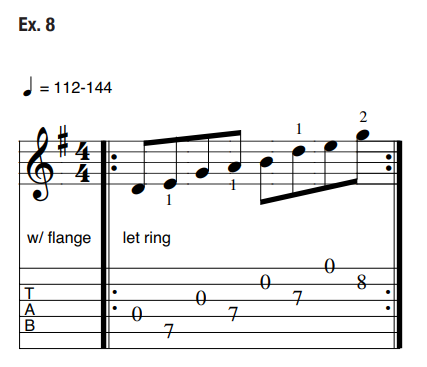
If you simply fret this G pentatonic phrase, it would sound bland. By setting up a pattern of alternating open and fretted notes, however, you turn this universal scale into an ear-grabber.
If you’re into ambient guitar or Steve Reich-inspired music, you’ll find lots of use for harptone lines. They sound particularly cool with synchronized delay.
For instance, play Ex. 9 at 92 bpm with a delay time of 163 milliseconds.

Don’t use any feedback (regeneration), and mix the single echo as loud – or nearly as loud – as your original note. The resulting sixteenth-note slap creates the illusion that you’re playing twice as many notes.
A delay time of 244ms yields a dotted-sixteenth delay and makes the phrase swing. It takes practice to play a lick steadily enough to lock into a synchronized delay, but the rippling sound is worth the effort.
Hunting for Harptones
Once you’ve digested these examples, you’ll be ready to find your own harptone licks. The principle is simple, says Donahue: “Whenever there’s a note in your line that can be played as an open string, go for it.
“You can always figure out a way to fret the next note without disturbing the sustaining open string. This often means fretting the note higher up the neck on a lower string than you’d normally select.”
You can hear Donahue play cascading harptone runs – as well as behind-the-nut bends and steel-like licks – on Telecasting Recast, a reworking of his ’88 solo album, Telecasting.
